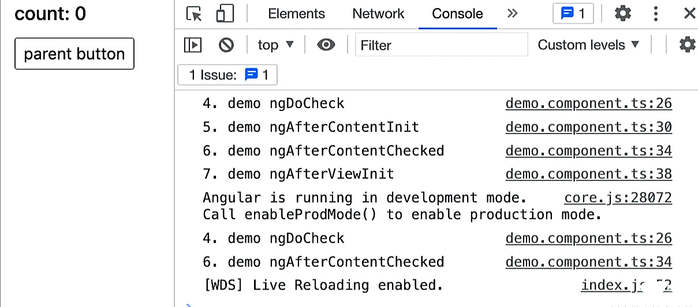
react 和 vue 开发的读者应该对生命周期这个概念不陌生。我们在使用 angular 开发的过程中,是避免不了的。【相关教学推荐:《angular教学》】lifecycle hooks。那么,在 angular 中,这些 hooks 都有哪些呢?了解它们,对你编写程序应该在哪里编写,很重要。
angular 中,生命周期执行的顺序如下:
- constructor 【常用,不算钩子函数,但是很重要】- ngOnChanges【常用】- ngOnInit【常用】- ngDoCheck - ngAfterContentInit - ngAfterContentChecked - ngAfterViewInit【常用】 - ngAfterViewChecked- ngOnDestroy【常用】
为了解说和验证,我们用 angular-cli 生成一个 demo 项目。
constructor
在 es6 中的 class 初始化对象的时候,constructor 会立即被调用。
class Person { constructor(name) { console.log('be called') this.name = name; }}let jimmy = new Person('jimmy'); // be calledangular 的组件本身就是导出一个类。当这个组件被 new 起来的时候,会获取 constructor 中的预设的值。
ngOnChanges
当我们有外部参数更改的时候,我们就会执行 ngOnChanges,也就是说组件中有 @Input 所绑定的属性值发生改变的时候调用。
简单说,父组件绑定子组件中的元素,会触发这个钩子函数,可以多次出发。这在下面的 ngOnInit 总会介绍。
ngOnInit
这个方法调用的时候,说明组件已经初始化成功。在第一次 ngOnChanges() 完成之后调用,且只调用一次。
// app.component.tsexport class AppComponent implements OnInit, OnChanges { constructor() { console.log('1. constructor') } ngOnChanges() { console.log('2. ngOnChanges') } ngOnInit() { console.log('3. ngOnInit') }}打印的信息如下:

咦?怎么没有打印 ngOnChanges 中的钩子函数信息呢?
上面已经说过了,需要触发条件 @Input 的属性值改变的时候。我们来修改一下:
// app.component.ts// AppComponent 类中添加属性public count:number = 0;
count: {{ count }}
// demo.component.tsexport class DemoComponent implements OnInit, OnChanges { @Input() public count: number; constructor() { console.log('1. demo constructor') } ngOnChanges() { console.log('2. demo ngOnChanges') } ngOnInit() { console.log('3. demo ngOnInit') }}
当通过 @Input 将值传递给子组件 demo 的时候,就会触发 demo 组件中的 ngOnChanges。
当 @Input 传递的属性发生改变的时候,可以多次触发 demo 组件中的 ngOnChanges 钩子函数。
// app.component.tsparentDemo() { this.count++;}ngDoCheck
当发生变化检测的时候,触发该钩子函数。
这个钩子函数,紧跟在每次执行变更检测时候 ngOnChanges 和首次执行执行变更检测时 ngOnInit 后面调用。
// demo.component.tsngDoCheck() { console.log('4. demo ngDoCheck')}这个钩子函数调用得比较频繁,使用成本比较高,谨慎使用。
ngAfterContentInit
当把外部的内容投影到内部组件,第一次调用 ngDoCheck 之后调用 ngAfterContentInit,而且只调用一次。
// demo.component.tsngAfterContentInit() { console.log('5. demo ngAfterContentInit');}
ngAfterContentChecked
ngAfterContentChecked 钩子函数在每次 ngDoCheck 之后调用.
// demo.component.tsngAfterContentChecked() { console.log('5. demo ngAfterContentChecked');}ngAfterViewInit
视图初始化完成调用此钩子函数。在第一次 ngAfterContentChecked 之后调用,只调用一次。
这个时候,获取页面的 DOM 节点比较合理
// demo.compoent.tsngAfterViewInit() { console.log('7. demo ngAfterViewInit');}
ngAfterViewChecked
视图检测完成调用。在 ngAfterViewinit 后调用,和在每次 ngAfterContentChecked 之后调用,也就是在每次 ngDoCheck 之后调用。
// demo.component.tsngAfterViewChecked() { console.log('8. ngAfterViewChecked')}ngOnDestroy
组件被销毁时候进行的操作。
// app.component.tspublic showDemoComponent: boolean = true;hideDemo() { this.showDemoComponent = false}// demo.component.tsngOnDestroy() { console.log('9. demo ngOnDestroy')}【完】
编程入门!!